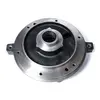Mobile:+86-311-808-126-83
Email:info@ydcastings.com
Exploring the Benefits and Techniques of Aluminium Metal Casting in Modern Manufacturing
The Process and Importance of Aluminium Metal Casting
Aluminium metal casting is a crucial manufacturing process that involves pouring molten aluminium into a mold to create components and products of various shapes and sizes. This technique has gained significant popularity across numerous industries, primarily due to aluminium's advantageous properties such as low density, high strength-to-weight ratio, excellent corrosion resistance, and good thermal and electrical conductivity. This article will explore the process of aluminium metal casting, its various methods, applications, and its importance in modern manufacturing.
The Aluminium Casting Process
The aluminium casting process typically involves several key steps. First, raw aluminium is sourced, often from recycled materials, which emphasizes the sustainability aspect of this practice. The aluminium undergoes melting in a furnace, where it can reach temperatures exceeding 660 degrees Celsius. Once the metal reaches a molten state, it is either gravity poured or pressure injected into a pre-prepared mold.
The mold can be made from various materials, including sand, metal, or ceramic, each offering distinct advantages based on the specific requirements of the final product. After the molten aluminium is poured into the mold, it is allowed to cool and solidify. Once solidified, the casting is removed from the mold, and any necessary finishing processes—such as machining, polishing, or painting—are applied to ensure the product meets the desired specifications and quality standards.
Types of Aluminium Casting Methods
There are several methods of aluminium casting, each suited for different applications
. The most common methods include1. Sand Casting This is one of the oldest and simplest forms of casting. It involves creating molds from a mixture of sand and a binding agent. Sand casting is versatile and cost-effective, making it ideal for producing large and complex shapes.
aluminium metal casting

2. Die Casting In this method, molten aluminium is injected under high pressure into a mold cavity. Die casting is known for producing parts with excellent dimensional accuracy and a smooth surface finish, making it popular in high-volume production environments.
3. Investment Casting Also known as lost-wax casting, this method involves creating a wax pattern, coating it in a ceramic shell, and then melting out the wax to create a mold. Investment casting offers high precision and is typically used for making intricate components in aerospace and medical industries.
4. Permanent Mold Casting This method uses reusable metal molds and is similar to die casting but involves less pressure. It is suited for producing parts that require good surface finish and strong mechanical properties.
Applications of Aluminium Castings
Aluminium castings are utilized in a multitude of industries, including automotive, aerospace, construction, and electronics. In the automotive sector, for instance, aluminium castings are used to manufacture engine blocks, transmission housings, and suspension components due to their lightweight nature and ability to withstand high temperatures.
In aerospace, lightweight aluminium parts help improve fuel efficiency without compromising on strength and safety. Additionally, the construction industry benefits from aluminium castings in window frames, door frames, and various structural components, owing to their corrosion resistance and durability.
Conclusion
Aluminium metal casting plays a pivotal role in modern manufacturing, providing essential solutions across various industries. The combination of aluminium's properties and the flexibility of casting techniques allows manufacturers to create complex shapes with high precision. As the demand for lightweight, strong, and corrosion-resistant materials continues to grow, the importance of aluminium casting will only increase, positioning it as a key player in sustainable manufacturing practices and technological advancements. With innovations in casting techniques and an increasing focus on recycling and sustainability, the future of aluminium metal casting looks promising and indispensable.
-
Impeller Technology That Powers Precision in Pump SystemsNewsMay.22,2025
-
Valve Durability Begins with Quality Cast Iron ComponentsNewsMay.22,2025
-
Performance Cooling with Advanced Automobile Water Pump SolutionsNewsMay.22,2025
-
How Motor Housing and Oil Pans Shape Engine PerformanceNewsMay.22,2025
-
How Metal Castings Drive Modern Manufacturing EfficiencyNewsMay.22,2025
-
Exploring the Engineering Behind Valve Body CastingsNewsMay.22,2025











